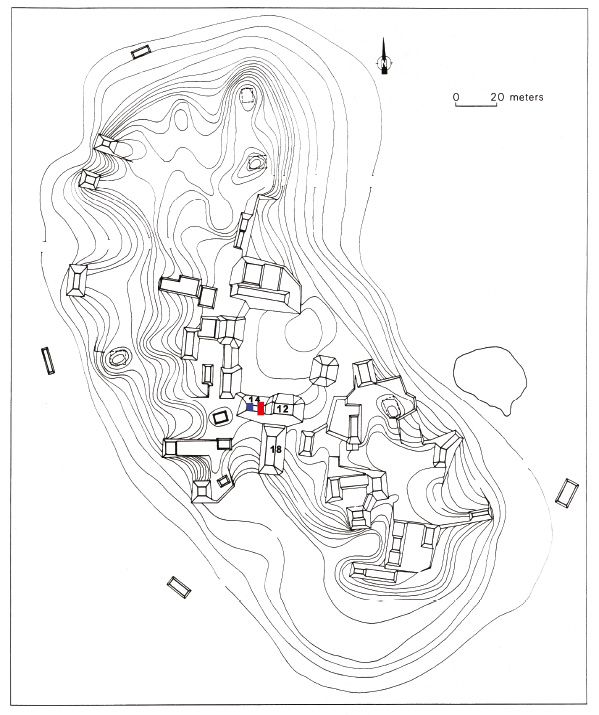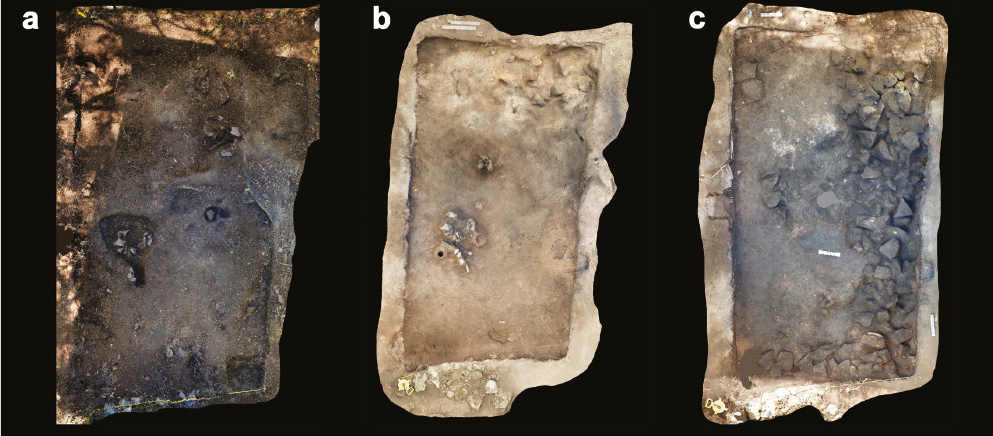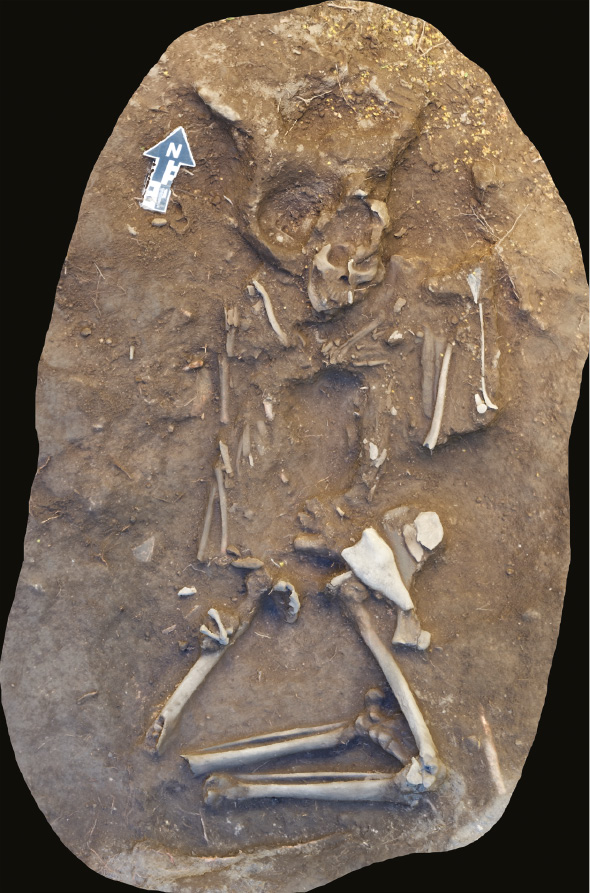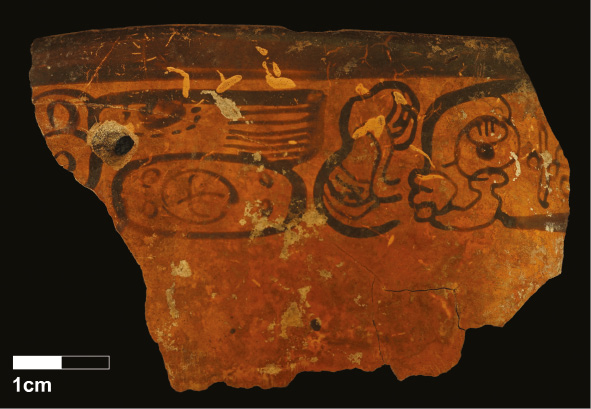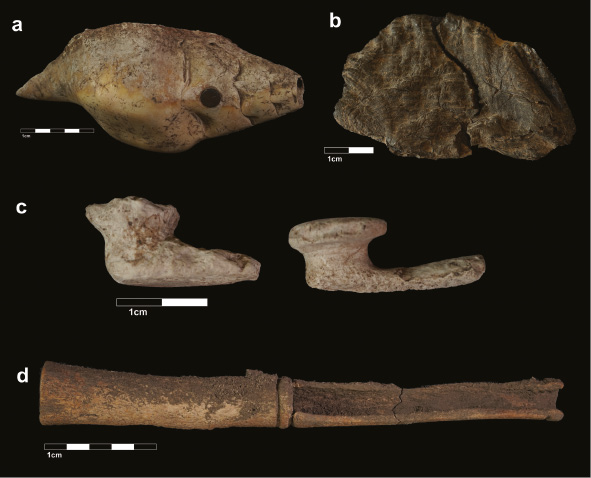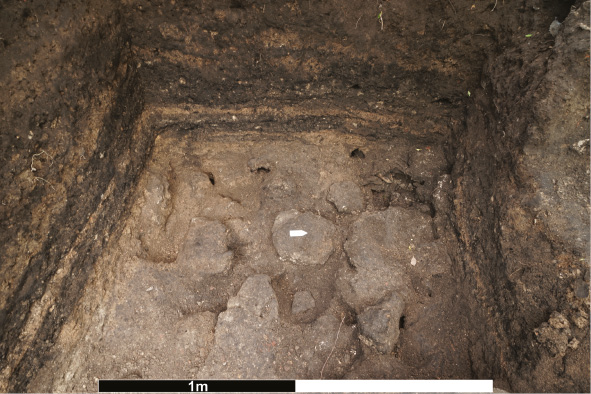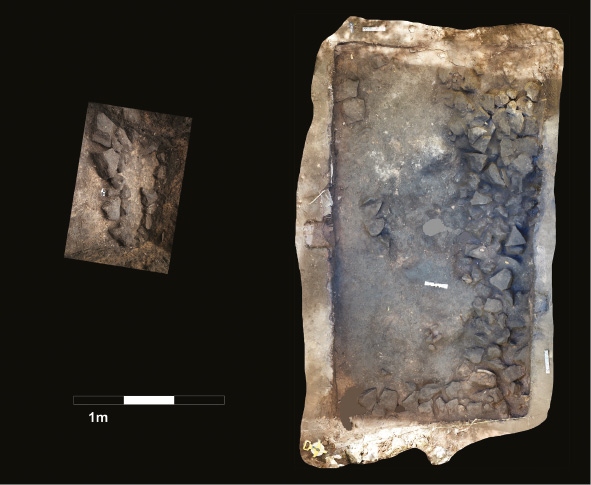Introduction
The 2023 field season represented the in-field commencement of a new collaboration between researchers at the Institute of Archaeology (Graham [PI] and Kratimenos), Michigan State University (MSU) (Wrobel and Marshall) and the State University of New York College at Geneseo (Aimers), as well as members of Archaeology South-East, the University of Belize, Galen University (Belize), Northern Michigan University (LaLonde), a team of 17 undergraduate students from MSU and the University of Michigan–Flint and the San Pedrano community. This collaboration – which marks a new phase of the Marco Gonzalez Archaeological Project – represents a continuation of many of the research priorities and directions of previous seasons (see Graham et al. 2016 for the last research report published in Archaeology International on this project), bolstered by novel approaches and methods which are outlined below.
Background and research context
‘Marco Gonzalez’ is the name given by Graham and Pendergast (1987, 1989) to a Precolumbian Maya archaeological site on the southern tip of Ambergris Caye, Belize (Figure 1), so-called after the 14-year-old San Pedrano (the demonym for inhabitants of the local town of San Pedro) who first made them aware of the site. Marco Gonzalez has a long occupation history from at least the Late Preclassic (400 bce) through to the Spanish colonial period (sixteenth century ce), although after the Early/Middle Postclassic (1200 ce) use was less intensive than in earlier periods (see Table 1). Of particular note is the fact that occupation at Marco Gonzalez persisted through the period of social and political transformation that marks the end of the so-called Classic period, traditionally referred to as the Maya Collapse. This transitional period at Marco Gonzalez, in addition to exhibiting an increase in commercial activity, also appears to have seen the adoption or innovation of a novel burial practice previously described as ‘ventrally placed, legs flexed’ (VPLF, after Donis 2014; see also Wrobel and Graham 2015). This burial position appears at a select few Maya sites, largely confined to the eastern Maya Lowlands and, in many cases, appears to be in some way associated with communities’ persistence through the ‘Collapse’ (Kratimenos forthcoming). To date, Marco Gonzalez represents the first appearance of this burial practice in the eastern Maya Lowlands, which suggests that the members of this relatively small (c. 6.5 ha) coastal community were able to exert a surprising amount of cultural influence on larger nearby polities such as the important inland site of Lamanai (Wrobel and Graham 2015; Graham and Howie 2021).
Chronology of Marco Gonzalez correlated with conventional chronological periods in Maya archaeology
| Dates | Chronological periods |
|---|---|
| 1544–1648 ce | Early Spanish Colonial |
| 1492–1544 ce | Terminal Postclassic |
| 1350–1492 ce | Late Postclassic |
| 1200/1250–1350 ce | Middle Postclassic |
| 960/1000–1200/1250 ce | Early Postclassic |
| 750/800–960/1000 ce | Terminal Classic (‘Maya Collapse’) |
| 600–750/800 ce | Late Classic |
| 250–600 ce | Early Classic |
| 1–250 ce | Terminal Preclassic |
| 300 bce–ce 1 | Late Preclassic |
| 600–300 bce | Middle Preclassic |
Economically, Marco Gonzalez appears to have been a crucial ‘trans-shipment hub’ (Sabloff and Rathje 1975), acting as the entrance point to the Chetumal Bay trading area (see Walker 2016) within the circum-peninsular, long-distance maritime trade and exchange network which existed during Precolumbian times. Owing to this role, Marco Gonzalez appears to have ‘punched above its weight’ considerably in terms of its regional influence and importance, as borne out by the wide variety of exotic goods, including obsidian, from a range of sources (Stemp et al. 2011; Simmons et al. 2023).
Recent research undertaken at Marco Gonzalez has focused on the long-term impact of human activities on soil formation (Graham et al. 2017; Macphail et al. 2017), particularly the extensive salt-processing industry (Aimers et al. 2015, 2016, 2017), which preoccupied the inhabitants of the site during the Late Classic period. In particular, the impact of this salt processing in conjunction with other facets of daily life at the site appears to have been crucial to the formation of fertile anthropogenic soils, known as Maya Dark Earths (Macphail et al. 2017), with implications for our understanding of the long-term environmental impact of human activities more broadly (see, for example, Graham et al. 2020; Evans et al. 2021; Turner et al. 2021). This research is crucial to a nuanced appreciation of past human activities, as well as having the potential to inform current debates and policy concerning human activity and its impact on our planet during the present Anthropocene era and increasingly urgent climate emergency. It is within this broader research context that the 2023 field season took place.
The 2023 field season: continuity and innovation
Planning for the 2023 field season first began in 2019, with the intention of undertaking fieldwork in the summer of 2020. This, of course, proved impossible owing to the Covid-19 pandemic; however, after a hiatus, the team was able to return to the field between May and July 2023. Excavations primarily centred on Structure 14, an approximately 13 m × 7.2 m stone-terraced platform that once supported a perishable superstructure or, more likely, a succession of superstructures. Structure 14 is situated on the south side of one of the larger plazas (Figure 2). Previous excavations on Structure 14 between 1986 and 2010 yielded no fewer than 38 burials, including many of the ‘VPLF’ type (Simmons and Graham 2016). All burials are associated with occupation, represented by successive floor constructions, of the Late Classic–Terminal Classic use of structures 14. It was a cultural practice in the Precolumbian Maya area to bury individuals beneath residential or civic-ceremonial building floors (McAnany 1995). Continuing excavations of this structure was one of our key priorities. Excavations were also conducted on Structure 18 to the south of the central plaza group, investigating a looter’s trench and associated spoil heap. Excavations were geared towards furthering our understanding of both the ‘VPLF’ phenomenon (in terms of its time-depth, demographic profile of those interred this way and extent) and the crucial questions surrounding the Late Classic salt-processing industry and its impact on soil formation processes at the site. Clearing of parts of platform faces revealed that Structure 14 had two construction phases, and excavations revealed more detailed information about the dating of construction than was known beforehand. The season’s research questions were addressed through continuation of previous excavation methods, bolstered by the implementation of novel techniques outlined below.
Photogrammetry and 3D modelling as a first-line documentation method
The 2023 field season saw the implementation of photogrammetry and 3D modelling as a recording and documentation method at Marco Gonzalez. These techniques were primarily utilised to record burials and caches in situ by Kratimenos prior to retrieval, with in-field modelling of special finds undertaken by MSU student Collin Sauter, who will continue to work alongside Wrobel and Marshall in modelling human remains in the MSU Bioarchaeology Laboratory. However, photogrammetry and 3D modelling were also used to document excavation progress with Operation 23-3 serving as a proof of concept. In this case, the c. 6.2 m × 3.5 m area situated on the eastern side of Structure 14 was 3D modelled at three points during excavation. These models and associated orthographic projections (Figure 3) provide a diachronic documentation of the excavation process, with each phase representing a discrete layer comprising different features as encountered by the excavation team. Future research by Kratimenos aims to explore innovative presentation and dissemination methods for these data, making use of the Unreal Engine 5 3D computer graphics game engine to experiment with more immersive and interactive possibilities.
In terms of in-situ burial recording, 3D modelling proved particularly advantageous owing to the extreme friability of human remains in tropical environments. While preservation of human remains at Marco Gonzalez – and on Ambergris Caye in general – is exceptional compared to many other areas of the Maya lowlands, disintegration during retrieval is inevitable. As such, high-quality 3D documentation of certain elements – particularly elements diagnostic of age and sex such as the cranium and pelvis – is of great value. Similarly, research on burial and grave context is bolstered by 3D modelling owing to the preservation of not just human remains but also grave goods in situ.
Operation 23-3: the ‘scribe’ burial
During the 2023 field season, seven burials (five from Structure 14: MG14/39, /40, /41, /42 and /43, and two from Structure 18: MG18/2 and /3) and elements of at least two individuals from looter’s backfill associated with Structure 18 were we excavated. Of these, perhaps the most intriguing is MG14/40, a young adult male situated at the northern end of Operation 23-3. This individual was positioned face-up with his legs flexed tightly in a cross-legged position, that is, a face-up variant of the ‘VPLF’ position seen at Marco Gonzalez (see, for example, Graham et al. 2013). Among the grave goods associated with this individual were a pair of shell ear spools, two obsidian bladelets, one complete gourd-shaped ceramic vessel identified as Macal Orange–Red, elements of at least two Late-to-Terminal Classic Peten Gloss Ware orange-polychrome vessels (probably Saxche Orange-polychrome), most likely originating from the Peten region of Guatemala and sherds of a Marvelita Black-on-red dish, probably originating from northern Belize, respectively, one bone needle and two conch shell inkpots and a long writing stylus made from a bird’s leg bone (see Figure 4). Moreover, several ceramic sherds bearing Maya hieroglyphic writing were excavated in contexts underlying the burial.
Orthographic projection of the ‘scribe’ Burial (Burial 14/40) from Operation 23-3. Note the presence of some of the grave goods found in association with this Burial such as the conch shell inkpot overlying the left hip, and the cluster of grave goods – including two obsidian bladelets, bone writing stylus and shell ear spool – placed to the east of the individual’s skull and left shoulder
Our working interpretation of Burial MG14/40 is that it represents the burial of a Precolumbian Maya scribe. The use of burial goods to confirm specific social roles with certainty is, of course, rife with confounding factors (see, for example, Parker Pearson 1982, 2003; Pinto 2012); however, this is perhaps the most intriguing example of a Maya burial found with objects associated with writing. Beyond the in-field osteological assessment undertaken by Kratimenos and Marshall, further lab-based osteological research will be undertaken by the team at MSU in the coming months. Moreover, various archaeological scientific methods – including radiometric dating, dental calculus analysis, isotopic analysis, ancient genome sequencing and archaeoparasitological analysis based on sacral soil samples on the human remains of this individual, as well as residue analysis on grave goods and obsidian sourcing analyses – will be utilised with a view to publishing a full ‘osteobiography’ (see, for example, Saul 1972; Saul and Saul 1989; Hosek and Robb 2019; Wrobel and Cucina forthcoming) of this individual in the near future.
Operation 23-2: hieroglyphs and the burial cache with no burial
The glyph-bearing sherds uncovered in Operation 23-3 were not the only examples found during the 2023 season, with the most impressive example recovered in Operation 23-2, which focused on the west side of Structure 14 (Figure 2). The sherd represents part of the rim of a drinking vessel and contains glyphs translated in the field by Belizean project colleague Frank Tzib as ujay yuk’ib (‘the drinking vessel [of]…’) (Figure 5). The sherd was embedded in the debris from Late Classic salt-processing layers.
Glyph-bearing sherd from the rim of a ceramic vessel uncovered in Operation 23-2. The glyph block to the left has been translated by our Belizean colleague Frank Tzib to read ujay yuk’ib (‘the drinking vessel [of]…’). As such, the two elements to the right of the sherd (the scroll element and the fish-head element) are presumably part of the name of the owner of this vessel (Source: photograph by Collin Sauter)
Intensive salt-processing activity at Marco Gonzalez preceded Structure 14 and indeed the establishment of the ‘town’ of which Structure 14 was a part. Stratigraphy and ceramic chronology indicate that the focus on producing and exporting salt took place in Late Classic times (eighth century ce), although ceramics recovered in the 2023 season suggest that the salt industry may have started at the end of the Early Classic period (c. 600 ce), coeval with the decline of the great city and commercial centre of Teotihuacan, in central Mexico (Braswell 2003). Teotihuacan is believed to have dominated, or at least heavily influenced, trade and exchange in Mesoamerica from Late Preclassic through to Early Classic times (Braswell 2003; Cowgill 2003). Marco Gonzalez is no exception in providing evidence of broad circum-peninsular trade in these periods.
The decline of Teotihuacan by 600 ce (Cowgill 2003, 332) would have generated a vacuum as well as a considerable degree of reorientation of trade and trade goods across Mesoamerica, and the rise of the salt industry at Marco Gonzalez may represent a local manifestation of this reorientation. The finding of a sherd from a finely painted polychrome vessel in debris from salt-processing levels – and the lack of almost any other kind of pottery except for the ‘Coconut Walk’ vessels used to make salt cakes – is not unusual. Graham’s (1994) excavations along the coast in Stann Creek and Murata’s (2011) work at Wits Cah Ak’al revealed a similar phenomenon, as did the earlier excavations at Marco Gonzalez. The indication is that along with salt export went a level of trade in fine polychromes. Why only fine polychromes, however, and not the variety of vessels and other materials that were moved along the coast both before the salt industry began and after it declined? This is a question we hope to pursue in further excavations.
In the northern extent of the area exposed by Operation 23-2, a cache was excavated which comprised several rare objects (both within Marco Gonzalez itself and, more broadly, across the Maya region). These items included a bone fan handle, a pair of shell ear spools similar in appearance to those discovered in Operation 23-3 in association with burial 14/40, several other pieces of worked shell jewellery, a lump of what we believe to be rubber (based on in-field analysis which must be confirmed in a laboratory setting) which still bears the imprint of the textile bag in which it may have been held and a shell ocarina worked to resemble a parrotfish (Figure 6). Aside from the intrinsic value to scholars of the finds within this cache, and the significance of their deposition in conjunction with one another, the cache is intriguing in the way in which it defies our expectations. The personal effects included in this cache, as well as the presence of a large quantity of cinnabar/haematite, traditionally associated with burials among the Precolumbian Maya (see, for example, Batta et al. 2013; Fitzsimmons 2009), spread across several of the cached objects, suggested to us that the objects represented grave goods. However, despite expansion of the excavation to the north, east and west of the cache, no bones associated with a burial were encountered.
A selection of some of the finds associated with the peculiar ‘grave goods’ deposit excavated in Operation 23-2: (a) a conch shell ocarina stylised to resemble a parrotfish; (b) a lump of what we identified in the field as rubber still bearing the imprint of what we assume to have been the textile bag within which it was held; (c) a pair of shell ear spools similar to those found in association with burial 14/40 in Operation 23-3; (d) a worked bone fan handle (Source: photographs by Collin Sauter)
The reasons for caching rather than interment remain unclear, although the matrix of the burials of Structure 14 – and, indeed, deposits throughout the site – are greatly disturbed. Apparently isolated objects were recovered in the 1990 excavations, yet the degree of disturbance of floors, soil and bones at Marco Gonzalez argues for caution in determining whether finds belong to a burial or were deliberately placed as a cache. All associated contexts in the case of this cache showed no signs of looting, making a good case for caching. Furthermore, examination of records of previous excavations indicate that no burials were found in this region of Structure 14 in previous seasons, precluding previous retrieval of the skeleton sans grave goods as an explanation. As such, we can provisionally assume that the deposition of this ‘grave good’ type cache without an associated burial was deliberate. Potential explanations for this phenomenon will be the subject of future research.
An industrial salt-processing hearth?
A key facet of previous research at Marco Gonzalez has focused on soil formation processes, with the presence of Maya Dark Earths – anthropogenic soils with huge potential to inform present debates and strategies in quantifying the long-term environmental impact of human activities, past and present – proving central to this theme. The processes underlying the formation of Maya Dark Earths are not yet fully understood; however, it seems likely that a significant contributory factor in their formation was the intensive salt processing that occurred at the site during the Late Classic period (Graham et al. 2017; Macphail et al. 2017).
Excavations during the 2023 field season provided intriguing further insights into Maya Dark Earth formation. Stratigraphic sections from Operation 23-2 reveal in greater detail (than did test pits excavated in 2013) the massive quantity of burnt wood used as fuel in driving off the water from brine to produce exportable salt, thus contributing extensive carbon to deposits and to dark earth formation (Figure 7).
Photograph looking west highlighting the stratigraphy of Operation 23-2 on the western and southern trench walls. Note the alternating layers of light and dark soils that appear to have been associated with the extensive salt-processing activities undertaken at the site during the Late Classic period. Lighter layers contained high concentrations of Coconut Walked Unslipped sherds, while darker layers contained an abundance of charcoal (Source: photograph by Collin Sauter)
Stone features revealed in the 2023 season in association with salt-processing debris had not been exposed in the earlier excavations (in 1986, 1990, 2010 or 2013), mainly because the 2023 interventions were more extensive than earlier seasons. The current working assumption is that this/these stone feature(s) delineated hearths that supported the Coconut Walk bowls used to drive off the water from brine in the salt production process (Reina and Monaghan 1981). Various charcoal samples have been collected in order to tie this feature to absolute dates by C14 dating. As it stands, stone features were revealed in both Operation 23-2 and Operation 23-3 (Figure 8); further excavations are required to confirm or refute their contiguity. Should this hypothesis be confirmed, however, it would represent a significant find in terms of reconstructing the mechanical processes by which industrial-scale salt production for export was undertaken at coastal Maya sites during the Late Classic period, as well as providing novel insights into the changing cultural and economic history of Marco Gonzalez itself over time.
Stone features seemingly associated with Late Classic salt-processing activities at Marco Gonzalez, uncovered during excavations in Operation 23-2 (left) and 23-3 (right), plotted in approximate association with one another to approximate scale. Further excavations are required to confirm or refute the contiguity of this/these feature(s) (Source: photograph (left) by Collin Sauter)
The world on the doorstep
Salt processing at Marco Gonzalez formed an integral part of the site’s economic strategy in the Late Classic period, presumably also associated with salting fish and marine foodstuffs for export to mainland sites in the eastern lowlands and potentially further afield. Producing salt on Ambergris Caye continued, in fact, to recent times. As noted above, however, the industrial level of production in the Late Classic appears to have been relatively chronologically restricted as there is little evidence for such large-scale processing either prior to or proceeding the Late Classic. As such, Marco Gonzalez is an intriguing site in the way it challenges widespread assumptions about ‘the norm’ in Precolumbian Maya civilisation.
A common theme in Maya historiography over the last century has been to portray the Classic period – with its political structure overseen by k’uhul ajawob (holy lords) and the elite-centric geopolitical feuding which this engendered – as the normative position or, at least, as the pinnacle of Maya civilisation. This perspective is one that owes much to the similarity perceived by the earliest Western European ‘explorers’ of the region between the profusion of monumental architecture seen in the so-called ‘Classic’ period and similar trends in the Classical Mediterranean. However, it has been argued that this interpretation is, in fact, more reflective of a Eurocentric model of unilinear social evolution rooted in the late eighteenth and nineteenth centuries that has become engrained in Maya historiography than any evidential basis (Kratimenos 2022). From the perspective of Marco Gonzalez, and other sites unfairly considered ‘peripheral’ to the Classic Maya ‘core’ of the Peten region of northern Guatemala (see Houk 2015 for a discussion), the picture looks very different. At Marco Gonzalez, the Late Classic can be considered more an aberration interrupting the longue durée pattern of long-distance trade and exchange than the defining theme of life at the site.
The centrality of long-distance trade and exchange to life at Marco Gonzalez, and its apparent privileged position as the gatekeeper to the Bay of Chetumal for maritime circum-peninsular trade, is a further theme which our most recent field season has drawn into focus. Several new finds have emphasised the scope of these trade relations. The span of Marco Gonzalez’s engagement with the wider ‘Mesoamerican World System’ (sensu Blanton and Feinman 1984) is evidenced by the discovery of various ceramics such as two fragments of Ulúa Marble from the Ulúa Valley, Honduras (see, for example, Luke and Tykot 2002, 2007; Skaggs et al. 2019), Tabi Gouged-incised ceramic rim sherds originating from the north of the Yucatan peninsula (Vallo 2002) and a Plumbate Ware (a ceramic type produced near the modern Pacific coast border of Guatemala and Mexico) vessel. Examples of obsidian from a variety of sources ranging from the Guatemalan highlands to Central Mexico – a range fewer only than those seen at Chichen Itza and Tikal (Simmons et al. 2023) – only serve to emphasise the site’s trading relationships with the furthest reaches of Mesoamerica.
The significance of Marco Gonzalez and future research directions
Marco Gonzalez is a site which consistently challenges preconceptions. Its small size belies its clear significance and influence on the broader Chetumal Bay region. The increasing evidence for exotic goods from across the entirety of Mesoamerica found at the site challenges the notion that trans-shipment sites saw goods moving through them but not generally remaining (unless broken or otherwise defective). Marco Gonzalez’s lack of monumental architecture and ostensible political autonomy even during the Classic period undermines assumptions about the totalising influence of the k’uhul ajawob. The ostensible affluence, based on grave goods and other finds, of many inhabitants of Marco Gonzalez hint at previously unappreciated social mechanisms by which wealth and, more significantly, status could be acquired beyond traditional interpretations centring on the patronage of political elites. Its persistence after the so-called Maya Collapse demands a broad-spectrum reconsideration of what precisely it was that ‘collapsed’ at the end of the Classic period and, further, why precisely it is that Maya scholars for over a century have centralised this time period in their conceptions of what exactly constitutes Precolumbian Maya ‘civilisation’ (see Aimers 2007 for discussion).
The highly fertile anthropogenic ‘Maya Dark Earths’ found at Marco Gonzalez give us tantalising insights into the breadth of possibility concerning the long-term environmental impact of human activity and begs consideration of how we can harness this potential in our own times to combat the increasingly urgent climate catastrophe we are all facing while, paradoxically, being very much at risk itself at the frontline of climate change. As such, Marco Gonzalez is a site that has huge potential to change the way we think, not just about the Precolumbian Maya past, but about the present. The 2023 field season not only provided us with intriguing new evidence with which to address such questions, it also raised new questions. Further research is required and the teams look forward now to continuing its collaborative project in the years to come.
Declarations and conflicts of interest
Research ethics statement
Not applicable to this article.
Consent for publication statement
Not applicable to this article.
Conflicts of interest statement
The lead author of this article is Deputy Editor of this journal. All efforts to sufficiently anonymise the authors during peer review of this article have been made. The authors declare no further conflicts with this article.
References
Aimers, JJ. (2007). What Maya collapse? Terminal Classic variation in the Maya lowlands. Journal of Archaeological Research 15 (4) : 329–377, DOI: http://dx.doi.org/10.1007/s10814-007-9015-x
Aimers, J; Haussner, E; Farthing, D. (2015). The ugly duckling: Insights into Ancient Maya commerce and industry from pottery petrography. Research Reports in Belizean Archaeology 12 : 89–95.
Aimers, J; Haussner, E; Farthing, D; Murata, S. (2016). An expedient pottery technology and its implications for ancient Maya trade and interaction In: Perspectives on the Ancient Maya of Chetumal Bay. Walker, DS (ed.), : 149–161. Gainesville: University of Florida Press.
Aimers, J; McCarron, K; Simmons, S; Graham, E. (2017). The pottery of Marco Gonzalez, Belize. Research Reports in Belizean Archaeology 14 : 363–372.
Batta, E; Argáez, C; Mansilla, J; Pijoan, C; Bosch, P. (2013). On yellow and red pigmented bones found in Mayan burials of Jaina. Journal of Archaeological Science 40 (1) : 712–722, DOI: http://dx.doi.org/10.1016/j.jas.2012.08.013
Blanton, R; Feinman, G. (1984). The Mesoamerican world system. American Anthropologist 86 (3) : 673–682, DOI: http://dx.doi.org/10.1525/aa.1984.86.3.02a00100
Braswell, GE (ed.), . (2003). The Maya and Teotihuacan, Reinterpreting Early Classic interaction. Austin: University of Texas Press.
Cowgill, GL. (2003). Teotihuacan and Early Classic interaction: A perspective from outside the Maya region In: The Maya and Teotihuacan, Reinterpreting Early Classic Interaction. Braswell, GE (ed.), : 315–335. Austin: University of Texas Press.
Donis, AE. (2014). Exploring the Movement of People in Postclassic and Historic Period Lamanai Using Stable Isotopes. MA dissertation. University of Western Ontario.
Evans, DL; Vis, BN; Dunning, NP; Graham, E; Isendahl, C. (2021). Buried solutions: How Maya urban life substantiates soil connectivity. Geoderma 387 114925 DOI: http://dx.doi.org/10.1016/j.geoderma.2020.114925
Fitzsimmons, JL. (2009). Death and the Classic Maya Kings. Austin: University of Texas Press.
Graham, E. (1994). The Highlands of the Lowlands: Environment and archaeology in the Stann Creek District, Belize, Central America. Monographs in World Archaeology 19. Madison, WA: Prehistory Press.
Graham, E; Evans, D; Duncan, L. (2020). The waste of time In: The Temporalities of Waste: Out of sight, out of time. Allon, F, Barcan, R; R and Eddison-Cogan, K K (eds.), : 151–166. London: Routledge.
Graham, E; Howie, L. (2021). Mobility as resilience: A perspective on coastal to inland migration in the Eastern Maya Lowlands In: Mobility and Migration in Ancient Mesoamerican Cities. Charlotte Arnauld, M, Beekman, C; C and Pereira, G G (eds.), : 109–130. Louisville: University of Colorado Press.
Graham, E; Macphail, R; Crowther, J; Turner, S; Stegemann, J; Arroyo-Kalin, M; Duncan, L; Austin, P; Whittet, R; Rosique, C. (2016). Past and future earth: Archaeology and soil studies on Ambergris Caye, Belize. Archaeology International 19 (1) : 97–108, DOI: http://dx.doi.org/10.5334/ai.1916
Graham, E; Macphail, R; Turner, S; Crowther, J; Stegemann, J; Arroyo-Kalin, M; Duncan, L; Whittet, R; Rosique, C; Austin, P. (2017). The Marco Gonzalez Maya site, Ambergris Caye, Belize: Assessing the impact of human activities by examining diachronic processes at the local scale. Quaternary International 437 : 115–142, DOI: http://dx.doi.org/10.1016/j.quaint.2015.08.079
Graham, E; Pendergast, DM. (1987). Cays to the Kingdom. Royal Ontario Museum Archaeological Newsletter, Series II. : 18.
Graham, E; Pendergast, DM. (1989). Excavations at the Marco Gonzalez site, Ambergris Cay, Belize, 1986. Journal of Field Archaeology 16 (1) : 1–16, DOI: http://dx.doi.org/10.1179/jfa.1989.16.1.1
Graham, E; Simmons, SS; White, CD. (2013). The Spanish conquest and the Maya collapse: How “religious” is change?. World Archaeology 45 (1) : 161–185, DOI: http://dx.doi.org/10.1080/00438243.2013.770962
Hosek, L; Robb, J. (2019). Osteobiography: A platform for bioarchaeological research. Bioarchaeology International 3 (1) : 1–15, DOI: http://dx.doi.org/10.5744/bi.2019.1005
Houk, BA. (2015). Ancient Maya Cities of the Eastern Lowlands. Gainesville: University Press of Florida, DOI: http://dx.doi.org/10.2307/j.ctvx070r2
Kratimenos, P. (2022). What’s so “classic” about the Maya Classic, anyway? Towards a Post-Postclassic In: Institute of Classical Studies ‘Disorienting the Classics’ Seminar Series, School of Advanced Studies. University of London. June 16 2022
Kratimenos, P. (Forthcoming). Burial Position and Mortuary Practice as Indicators of Cultural and Political Change during the Maya ‘Collapse’. PhD dissertation. UCL.
Luke, C; Tykot, RH. (2002). Marble sources and artifacts from the Ulúa valley, Honduras In: Asmosia V: Interdisciplinary Studies on Ancient Stone. Hermann, JJ, Herz, N; N and Newman, R R (eds.), : 394–406. London: Archetype Publications.
Luke, C; Tykot, RH. (2007). Celebrating place through luxury craft production: Travesia and Ulúa style marble vases. Ancient Mesoamerica 18 (2) : 315–328, DOI: http://dx.doi.org/10.1017/S095653610700020X
Macphail, RI; Graham, E; Crowther, J; Turner, S. (2017). Marco Gonzalez, Ambergris Caye, Belize: A geoarchaeological record of ground raising associated with surface soil formation and the presence of a Dark Earth. Journal of Archaeological Science 77 : 35–51, DOI: http://dx.doi.org/10.1016/j.jas.2016.06.003
McAnany, P. (1995). Living with the Ancestors: Kinship and kingship in Ancient Maya Society. Austin: University of Texas Press.
Murata, S. (2011). Maya Salters, Maya Potters: The archaeology of multicrafting on non-residential mounds and Wits Cah Ak’al, Belize. PhD dissertation. Boston University.
Parker Pearson, M. (1982). Mortuary practices, society and ideology: An ethnoarchaeological study In: Symbolic and Structural Archaeology. Hodder, I (ed.), : 99–113. Cambridge: Cambridge University Press.
Parker Pearson, M. (2003). The Archaeology of Death and Burial. Stroud: The History Press.
Pinto, M. (2012). Reflecting on the Grave and the Bones Within: A locus for individual will, action and identity. Oxford: British Archaeological Reports International Series 2425.
Reina, RE; Monaghan, J. (1981). The ways of the Maya. Expedition 23 (3) : 13–33.
Sabloff, JA; Rathje, WL. (1975). A Study of Changing Pre-Columbian Commercial Systems: The 1972–1973 seasons at Cozumel, Mexico. Cambridge, MA: Monographs of the Peabody Museum. No. 3.
Saul, FP. (1972). The human skeletal remains of Altar de Sacrificios: An osteobiographic analysis. Papers of the Peabody Museum of Archaeology and Ethnology 63 (2) DOI: http://dx.doi.org/10.1002/ajpa.1330400320
Saul, FP; Saul, JM. (1989). Osteobiography: A Maya example In: Reconstruction of Life from the Skeleton. İşcan, MI, Kennedy, KAR KAR (eds.), : 287–302. New York: Allan R. Liss.
Simmons, S. E; Graham, E. (2016). Maya coastal adaptations in Classic and Postclassic times on Ambergris Caye, Belize In: Trading Spaces: The Archaeology of Interaction, Migration and Exchange. Patton, M, Manion, J J (eds.), : 167–180. Proceedings of the 46th Annual Chacmool Archaeology Conference, Chacmool Archaeology Association. University of Calgary. November 2013, Calgary, Alberta, Canada
Simmons, SE; Stemp, WJ; Ferguson, JR; Graham, E. (2023). Recent pXRF analysis of obsidian from Marco Gonzalez, Ambergris Caye, Belize. Mexicon 45 (3) : 65–74.
Skaggs, S; Tykot, RH; Powis, TG. (2019). Isotopic analysis of newly discovered fragments of an Ulúa valley marble vase at the Ancient Maya site of Pacbitun, Belize. Journal of Archaeological Science: Reports 26 101896 DOI: http://dx.doi.org/10.1016/j.jasrep.2019.101896
Stemp, WJ; Graham, E; Goulet, J. (2011). Coastal Maya obsidian trade in the Late Postclassic to Early Colonial period: The view from San Pedro, Ambergris Caye, Belize. Journal of Island and Coastal Archaeology 6 (1) : 134–154, DOI: http://dx.doi.org/10.1080/15564894.2010.487366
Turner, S; Graham, E; Macphail, R; Duncan, L; Rose, NL; Yang, H; Whittet, R; Rosique-Esplugas, C. (2021). Mercury enrichment in anthrosols and adjacent coastal sediments at a Classic Maya site, Marco Gonzalez, Belize. Geoarchaeology 36 (6) : 875–896, DOI: http://dx.doi.org/10.1002/gea.21868
Vallo, M. (2002). Die Keramik Von Xkipché. Oxford: British Archaeological Reports International Series 1056.
Walker, DS (ed.), . (2016). Perspectives on the Ancient Maya of Chetumal Bay. Gainesville: University of Florida Press.
Wrobel, G; Cucina, A. (Forthcoming). Mesoamerican Osteobiographies: Revealing the lives and deaths of Ancient individuals. Gainesville: University Press of Florida.
Wrobel, G; Graham, E. (2015). The Buk phase burials of Belize: Testing genetic relatedness among Early Postclassic groups in Northern Belize using dental morphology In: Archaeology and Bioarchaeology of Population Movement among the Prehispanic Maya. Cucina, A (ed.), : 85–95. Cham: Springer.



